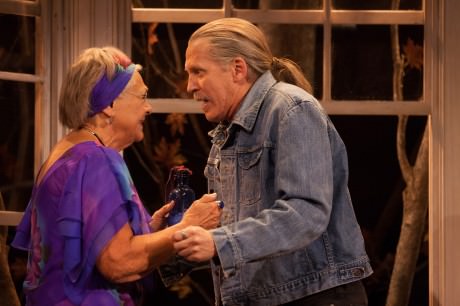For $64,000, the funny thing about aging is…?
Funny like strange or funny like—?
Like LOL.
Oh, okay, lemme think. [Thinks a long time; lame music plays.]
Haven’t got all day.
Please, I need more time!
Come on, clock’s ticking.
No, wait!
Nope. Time’s up. Your final answer. Now.
Um…um…lemme guess— [Over sound of nasty buzzer:] The Velocity of Autumn?
Correct! The answer to the $64,000 question “What could possibly be funny about old age?” is Eric Coble’s deliriously hilarious new comedy, The Velocity of Autumn!
[Leaving isolation booth to audience applause:] Whew! Who knew?
There’s a snappy-happy production smartly directed by Molly Smith now delighting playgoers at Arena Stage. You should hurry up and catch it.
Um, why’s that?
Because life is short and you deserve the last belly laugh.

The Velocity of Autumn is indeed a wonderfully well-wrought comedy. The night I was there, the laughter let up only during passages that pulsed with the play’s emotional core, a touching story of mother-and-son resentment and reconciliation. And the audience loved it. They rose to their feet at the end as one.
The octogenarian Alexandra (played with boundless spunk by Estelle Parsons) has barricaded herself in her Brooklyn brownstone armed with dozens of molotov cocktails. Her three grown children are plotting to relocate her to a home. But this is her home, dammit. She is determined to stay put in it till death. And if anyone messes with her intention, she’ll blow up the nabe.
Into this arsenal of angry defiance comes her middle-age son Chris (played with fine-spun sensitivity by Stephen Spinella), who enters clambering through the window having climbed a tree. A standoff ensues, a comic contretemps between this would-be artist (who is still a lost boy) and his apparently deranged mother (who is actually sharp as a tack). The spry-witted Alexandra proceeds to treat us to such a spate of hysterical one-liners about late-life decrepitude that our lungs gasp for air.
Two rich, rewarding, and intertwined stories are going on here. One is an outrageously over-the-top rendering of a real-life drama now being played out in countless families across the country: boomers wrestling with their responsibilities to care for infirm parents, elders dreading the loss of autonomy that lies ahead. The landscape that an actual Chris and Alexandra would inhabit is one where so-called universal design is promoted as an aid to independent living and the grassroots “Village” movement (now in several District neighborhoods) offers help to those growing older who wish to stay in their own homes. Judging from all the elderly in attendance, several of whom had mobility challenges of their own, not a few folks there felt a personal connection to Parsons’ superb portrayal of Alexandra that may well have transformed her mother lode of humor into a load off their mind.
Alexandra has several funny riffs on the theme of wanting to be alone. She was alone as a free-spirited young artist when she traveled the world. She met her husband, settled down, and raised children—which interrupted the solitude she really relished. And now she is again alone at last. Alexandra likes being alone. (“I’m good at it,” she says). But Alexandra’s funny quips notwithstanding, the reality is that old age can be isolating in a not-at-all-fun way—which is why The Velocity of Autumn comes close to being a kind of theatrical therapy. For those who can relate, it offers 90 laugh-filled minutes of respite from feeling alone before winter sets in. I suspect Coble knows this but astutely never lets on. (This play is deservedly destined for Broadway, after all, not Retirement Living TV).
The other story is about the lifeline between mother and son, a tether stretched nearly to nonexistence over the years but now—in Chris and Alexandra’s sometimes-brutal verbal tug-of-war—stands a chance of being again a tie that binds. Coble introduces this rapprochement almost by stealth: The two begin talking about art, going to art museums together, looking at art, talking about it. In a tender reminiscence, Chris realizes that his mother has taught him how to look, how to watch, how to see. Over the the course of Coble’s exquisitely written script, mother and son relearn to see each other. And as performed by Spinella and Parsons—who deliver a master class in acting—it is a beautifully hopeful and satisfying sight to behold.
Running time: 90 minutes, with no intermission.

The Velocity of Autumn plays through October 20, 2013 at Arena Stage at the Mead Center for American Theater’s Kreeger Auditorium – 1101 Sixth Street, SW in Washington, DC. For tickets, call the box office at (202) 488-3300, or purchase them online.
LINKS
Review of The Velocity of Summer by Nicole Cusick on DCMetroTheaterArts.
An Interview with Playwright Eric Coble on His Play The Velocity of Autumn at Arena Stage by Joel Markowitz.
Read other reviews of The Velocity of Autumn in ‘Other Reviews.’




